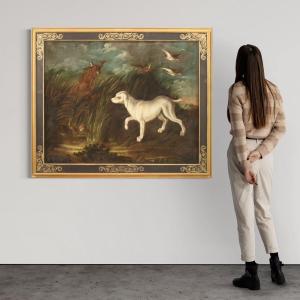Andromeda freed by Perseus
Oil on canvas, 172 x 155
With frame cm 195 x 177
Cassiopeia, queen of Ethiopia, one day boasted the beauty of her daughter Andromeda, she said superior to that of the Sea Nereids. Offended by the outrage, Anphrite, mother of these latter, convinced Poseidon to avenge the honor of the daughters: it was commanded that Ceto, sea monster, rise from the depths of the sea and devastate the coasts of Ethiopia. The only solution to appease his fury was to sacrifice Andromeda. Chained to a rock, the princess was spotted by the hero Perseus, who was accidentally flying over the area, rushing off after taking off the Medusa. With the severed head of this, the hero petrified the monster and could thus save the maiden
In the present painting is depicted the instant after the liberation of Andromeda: Perseus, still wearing the winged boots used to fly, has now released her from the chains and tenderly supports her, newly-fallen in love. Some sea gods are coming to celebrate the victory: a merman on the right is playing a horn, while another personification, crowned with seaweed, helps bring Andromeda safe, sitting on the petrified monster. In the latter we can recognize a further development of the myth: from the petrified blood of the monster, corals were born, joyfully welcomed by the marine community of newts and nereids.
The painting denounces the immediate matrix of Venice, prevailing despite the cloth that glides from Andromeda, Ferrara in the dense ravvolgings that fall from a shoulder of the young woman. A warm chromatism winds over the bodies of the retreated, illuminating and flooding with shadows on occasion the muscles in an ascending motion, at its apex in the triton with horn. Compositional arrangement, twists and delicate movements refer to the cultural season fiercely Venetian Titian, as immediately recalled by a graft of the Veronese (Perseus libera Andromeda,1576-1578 Rennes, Musee des Beaux Arts).
In the last quarter of the sixteenth century, the life of the four main artists of the time came to an end in the Veneto hinterland: Tiziano, Tintoretto, Veronese and Bassano. On their escort, the famous pen of Marco Boschini (The rich mines of Venetian painting) distinguished seven ways to be obtained from as many artists, which intinsti inspiring motif from them. Among the seven, Jacopo Negretti, better known as Palma il Giovane, reflected a material pragmatism similar to the present, concentrating mythological scenes in voluminously animated compositions. The same Andromeda liberated by Perseo (Museum Schloss Wilhelmshöhe, Gemäldegalerie Alte Meister, Kassel) opens an episodic sequel in which they are to be inserted, related to the present, The three Graces (Academy of St. Luke, Rome and coll.priv.) and Loth and the daughters (Amsterdam, Rijksmuseum). Symptomatic that other artists such as Paolo Fiammingo (L'amore Letheo, Vienna, Kunstistorisches Museum), Felice Brusazorci (Loth and the daughters, coll. priv.) and Pietro Mera (La caduta dell'uomo, Walters Art Museum Baltimora e Diana e le ninfe prese da Atteone, coll. priv.) have assimilated the same modules of the present, in the context of Veneto panism of the late sixteenth century.The subject is not new in the hinterland of the Serenissima: by collecting the vision of Bonifacio de' Pitati (Perseus and Andromeda, Bergamo, Accademia Carrara), the present artist approaches the lexicon of Titian from the middle of the century. If Andromeda freed by Perseus of Titian (Wallace Collection, London), commissioned by Philip II of Spain, introduces the fine jewels worn by the princess, it is in Mars that strips Venus (Edinburgh, National Gallery of Scotland) and Venus and Mars united by Love (The Met, New York) of the Veronese that it is possible to see the same, docile proximity of the two lovers.








































 Le Magazine de PROANTIC
Le Magazine de PROANTIC TRÉSORS Magazine
TRÉSORS Magazine Rivista Artiquariato
Rivista Artiquariato